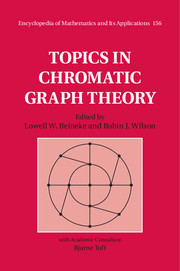Book contents
- Frontmatter
- Contents
- Foreword
- Preface
- Preliminaries
- 1 Colouring graphs on surfaces
- 2 Brooks's theorem
- 3 Chromatic polynomials
- 4 Hadwiger's conjecture
- 5 Edge-colourings
- 6 List-colourings
- 7 Perfect graphs
- 8 Geometric graphs
- 9 Integer flows and orientations
- 10 Colouring random graphs
- 11 Hypergraph colouring
- 12 Chromatic scheduling
- 13 Graph colouring algorithms
- 14 Colouring games
- 15 Unsolved graph colouring problems
- Notes on contributors
- Index
- References
8 - Geometric graphs
Published online by Cambridge University Press: 05 May 2015
- Frontmatter
- Contents
- Foreword
- Preface
- Preliminaries
- 1 Colouring graphs on surfaces
- 2 Brooks's theorem
- 3 Chromatic polynomials
- 4 Hadwiger's conjecture
- 5 Edge-colourings
- 6 List-colourings
- 7 Perfect graphs
- 8 Geometric graphs
- 9 Integer flows and orientations
- 10 Colouring random graphs
- 11 Hypergraph colouring
- 12 Chromatic scheduling
- 13 Graph colouring algorithms
- 14 Colouring games
- 15 Unsolved graph colouring problems
- Notes on contributors
- Index
- References
Summary
In this chapter we address a colourful area of geometric graph theory: finding the chromatic number of the plane and related problems. In addition to results, we present open problems of a classical kind that are easy to understand, but hard to solve.
The chromatic number of the plane
In the definition of a graph, edges symbolize the adjacency of points and nothing else: we ignore their shape and length. However, the past century has witnessed a great deal of interest in geometric graphs, where geometrical considerations such as distance define the adjacency. The wealth of material related to geometric graphs is so vast that one can easily imagine a book written on this topic alone. In view of space and time limitations and our emphasis on chromatic graph theory, we have chosen to go deep and address a small but colourful area of geometric graphs: the problem of finding the chromatic number of the plane and related problems. My monograph [45] did not appear in that book.
We can create a graph G from the Euclidean plane E2 by taking all of its points as vertices, and joining two vertices by an edge if and only if they are at distance 1 apart. More generally, we call a graph unit-distance when any two vertices are adjacent if and only if they are at distance 1 apart. The main open problem in the subject is as follows.
Problem Find the chromatic number of the above graph G.
This number is called the chromatic number of the plane (CNP) and is denoted by χ(E2). As outlined in [45], this problem was created in late 1950 by the 18-year-old Edward Nelson, who determined a lower bound; his 20-year-old friend John Isbell found an upper bound:
4 ≤ χ(E2) ≤ 7 – that is, χ(E2) = 4, 5, 6 or 7.
- Type
- Chapter
- Information
- Topics in Chromatic Graph Theory , pp. 161 - 180Publisher: Cambridge University PressPrint publication year: 2015
References
- 2
- Cited by

